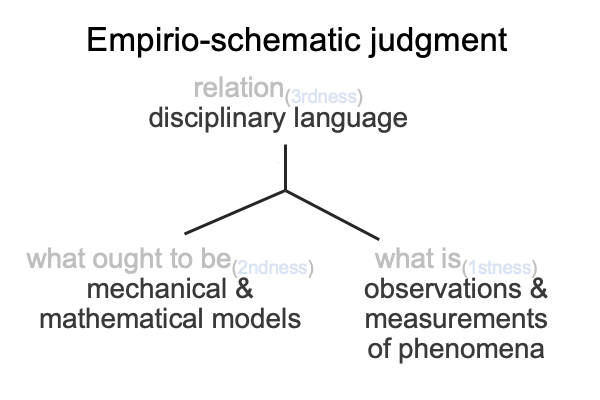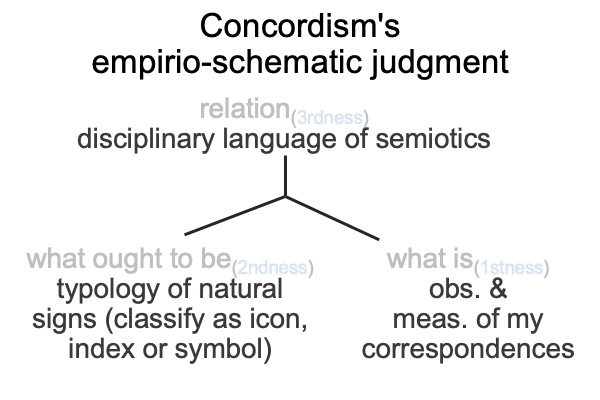0103 The next set of chapters (seven through eleven) challenge the exultation of grace3c and nature3c through a doctrine (an “ism”) of harmony (“concord”).
The title of chapter 7 is “Concordism and Science”.
In this chapter, Ross reminds the reader that a divided Christendom gives birth to science. The Reformation brings the Bible back to front and center. The Bible exhorts the believer to test everything. The Bible offers subject matter that comports with the scientific method of observation, modeling and technical specification. Scientific disciplinary languages encourage literal and plain readings. So, most of all, the Bible can be plainly read for exoteric meaning.
But, there is always an esoteric meaning hidden within that plain reading.
For example, today, the second day of the Creation Story (Gen. 1:6-9) appears, to a scientist, to be a phenomenological description of an evolutionary process. To this reader, the second day contains poetic icons and images and symbols of the accretion of the Earth and Moon. The hidden presence of a correspondence becomes apparent to anyone with scientific knowledge. But, can I make this esoteric impression into an exoteric demonstration?
Say what?
As a scientist, can I construct an empirio-schematic judgment that plainly expresses what my intuition is privately telling me?
I say, “Yes. Indeed, this is precisely what scientists do in formulating hypotheses.”
0104 Here is a general picture of the empirio-schematic judgment.

A disciplinary language (relation, thirdness) brings models (what ought to be, secondness) into relation with observations and measurements of phenomena (what is, firstness)
How would the empirio-schematic judgment apply to a what ought to be that is both concordist and Positivist?
To start, the phenomena might be my correspondences between a Creation Story day and a relevant evolutionary period.
My observations might classify the correspondences in terms of specific types. That would be close to a model.
Finally, I would need a specialized disciplinary language (that is not “metaphysical” in the sense of “religious”) capable of formulating the designation of specific types.
0105 Here is a picture of my proposal of the empirio-schematic judgment for concordism.

0106 Since Ross does not know about the Positivist’s judgment or the empirio-schematic judgment, this will be something a surprise. In a way, this examination serves as an introduction to Razie Mah’s e-book, Exercises in Artistic Concordism (available at smashwords and other e-book venues).
Nevertheless, the above diagram does not contradict Ross’s argument in chapters 7 and 8.
0107 Back to the figure.
The disciplinary language of semiotics (or triadic relations) (relation, thirdness) brings a typology of natural signs, corresponding the Peirce’s list of icons, indexes and symbols (what ought to be, secondness), into relation with my construction of correspondences between each Creation Story day and a relevant evolutionary epoch (what is,firstness).
0108 This figure is not the same as the judgment regarding the distinction and separation of the terms, “grace” and “nature” (see points 0056 through 0059). In many ways, it is a rejection of this judgment, using the vehicle of a judgment that is integral to the scientific revolution (that is, the empirio-schematic judgment).
0109 In this figure, I make observations and measurements of phenomena, knowing that, for the past eight centuries, the noumenon is untenable. Two separate parties have flourished under the judgment that this noumenon is untenable. Yes, both modern theologians (the ones who conduct unnecessary concessions, according to Ross) and modern scientists (the ones who say that Genesis is not history in a modern sense, that the Creation Story does not compare to the evolutionary sciences, and that the Bible derives from… um… ancient Near Eastern civilizations) reject the claim that “grace” and “nature” are like matter and form in the human being.
0110 Modern theological and scientific experts do not know that they agree to this rejection.
Neither does Hugh Ross.
But, in chapters 7, 8, 9 and 10, I sense that Ross might catch the drift that the modern disarticulated version of “dual revelation” operates as an impediment to his aesthetic strivings.
He asks, “Why can’t my impressions of correspondences between each Creation Story day and a revelant evolutionary epoch (what is, firstness) be regarded as real?”
He does not ask why they cannot be regarded as phenomena.
He does not ask why God’s grace no longer flows into our human nature.
In chapters 8 and 9, Ross confronts various “models” that reflect the consensus that “grace” and “nature” are distinct and separate concepts. These “models of Bible and science” offer various recipes for coping with the consensus. But, they do not offer anything close to a schematic. I mean, look at the title of the above figure, empirio- (empirical) -schematics (formulations).
Yes, I can regard Ross’s correspondences as phenomena.
